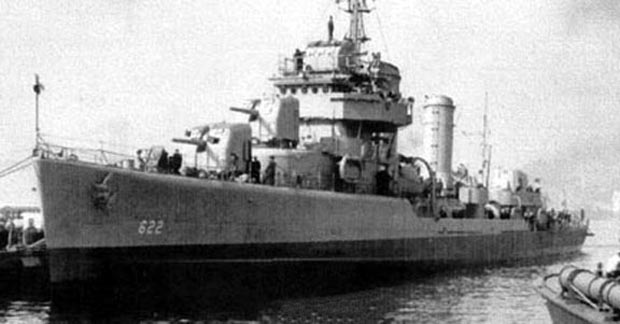 |
 |
| USS Maddox (DD-622) |
| Three U.S. Navy ships have been named Maddox: DD-168, DD-622, and DD-731. All three were named in honor of Captain William |
| Alfred Maddox, a U.S. Marine Corps officer from Charles County, Maryland, who served during the first half of the nineteenth century. |
| Federal Shipbuilding of Kearny, New Jersey, built the second USS Maddox (DD-622) and launched her on September 15, 1942. |
| After the ship passed a series of required sea trials, the Navy commissioned her on October 31, 1942. |
| At 348 feet long and 36 feet wide at the beam, the new USS Maddox displaced 1,630 tons, with a draft of seventeen feet, five inches. |
| Twin-screw 50,000 horsepower Westinghouse geared turbines with high-pressure super-heated boilers turned out a top speed of 37 |
| knots. Cruising at an average speed of 12 knots, the ship had a range of 6,500 nautical miles. |
| With Lieutenant Commander Eugene S. Sarsfield in command, the Maddox departed New York on January 2, 1943, en route to Norfolk, |
| Virginia. On station at Norfolk, the new destroyer began performing escort duty. After two missions accompanying oil tankers between |
| Norfolk and Galveston, Texas, the Maddox embarked on a series of trans-Atlantic crossings escorting troop convoys from New York and |
| Norfolk to north Africa. On June 8, 1943, the Maddox departed Norfolk for Oran, Algeria, where it joined Task Force 81, one of three |
| separate naval forces then assembling in the Mediterranean Sea for Operation HUSKY, the joint British, U.S., and Canadian amphibious |
| assault planned for the Italian island of Sicily. On July 10, 1943, as the invasion took place on shore, the Maddox cruised sixteen miles |
| off the coast of Gela, Sicily, conducting antisubmarine patrols. Having inexplicably wandered from the main destroyer pack, the Maddox |
| came under attack from a four-man German dive bomber that came down out of the sun, gliding quietly with its engines off. Personnel |
| aboard the Maddox had no idea they were under attack until they heard the whistling of the falling bombs. The first fell short by twenty- |
| five yards; the second struck the propeller guard and detonated depth charges lined up on the aft deck. The initial blast caused the ship |
| to settle by the stern; then it lost steering and headway, as steam billowed from the starboard main deck and number two stack. The |
| ship listed slightly to port, then suddenly capsized to starboard and sank -- all within two minutes. Chief Water Tender Thomas Stevens, |
| at his station in a boiler room far below decks, could not reach the surface. He and 211 shipmates perished; 74 managed to survive. |
| Tom Steven's widow, Virginia, recalled how apprehensive he felt before that last voyage. He told her the Maddox was grossly overloaded, |
| carrying extra ammunition for the cruisers in the convoy. "Even the fire hoses," he told her, "were uncoiled on deck and filled with small |
| caliber rounds. If we take just one hit, we will blow up like a bomb." On the morning of their last day together, Tom sat with his wife at |
| the kitchen table and reviewed the details of what she would have to do in the event of his death. As he rose to leave for the ship, he |
| reached out and handed Virginia his pocket watch -- his most prized possession. |
|
Sources: Dictionary of American Naval Fighting Ships; USS Maddox Destroyer Association; and the personal recollections of Mrs. |
|
Virginia Plummer. For a brief but excellent overview of Operation HUSKY and the sinking of the USS Maddox, see: Atkinson, Rick |
| The Day of Battle (Henry Holt and Company, New York, c2007), specifically pages 80 and 81. |
|
|